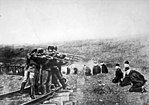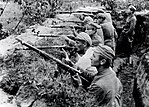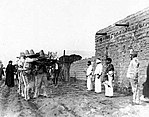User:Mu/Sandbox3: Difference between revisions
No edit summary |
No edit summary |
||
| Line 52: | Line 52: | ||
}} | }} | ||
The '''Nuxican Revolution''' ({{wp|Catalan language|Floren}}: ''Revolució Nuxicana''), also known as the '''Great Chaos''' ({{wp|Catalan language|Floren}}: ''Gran Caos''), '''the Lost Fifteen''' ({{wp|Catalan language|Floren}}: ''Els Quinze Perduts'') or the '''Nuxican Civil War''' ({{wp|Catalan language|Floren}}: ''Guerra Civil Nuxicana'') was a major civil, military, and political struggle in [[Nuxica]] fought from 1915 to 1928. [[Nuxican Army]] forces -- known as the ''[[Carutagua government|Federals]]'' -- loyal to the {{wp|centre-right politics|centre-right}} [[Carutagua government|government]], in an alliance with the {{wp|Right-wing politics|right-wing}} to {{wp|Far-right politics|far-right}} [[National Front for Traditional Rights and Piety]] -- known as the ''[[Cochuca government|Blancs]]'' -- from 1920 onward, against a revolt against the {{wp|far-left politics|far-left}} umbrella organization [[United Army of the Labor Class]] -- known as the [[Estancaja government|Vermells | The '''Nuxican Revolution''' ({{wp|Catalan language|Floren}}: ''Revolució Nuxicana''), also known as the '''Great Chaos''' ({{wp|Catalan language|Floren}}: ''Gran Caos''), '''the Lost Fifteen''' ({{wp|Catalan language|Floren}}: ''Els Quinze Perduts'') or the '''Nuxican Civil War''' ({{wp|Catalan language|Floren}}: ''Guerra Civil Nuxicana'') was a major civil, military, and political struggle in [[Nuxica]] fought from 1915 to 1928. [[Nuxican Army]] forces -- known as the ''[[Carutagua government|Federals]]'' -- loyal to the {{wp|centre-right politics|centre-right}} [[Carutagua government|government]], in an alliance with the {{wp|Right-wing politics|right-wing}} to {{wp|Far-right politics|far-right}} [[National Front for Traditional Rights and Piety]] -- known as the ''[[Cochuca government|Blancs]]'' -- from 1920 onward, against a revolt against the {{wp|far-left politics|far-left}} umbrella organization [[United Army of the Labor Class]] -- known as the [[Estancaja government|Vermells]]. | ||
The conflict began when government forces under the authority of [[President of the Republic of Nuxica|President]] [[Aquilles Pinta|Aquilles Pintà i Puigdellivol]] crushed a {{wp|general strike}} in the city of [[Estancaja]], prompting the [[Nuxican Revolutionary League]], the [[Syndicalist Party of Nuxica]], and the [[Social Democratic Labor Party (Nuxica)|Social Democratic Labor Party]] to arm themselves and unite under the [[United Army of the Labor Class]] ({{wp|Catalan language|Floren}}: Exèrcit | The conflict ended with the [[Execution of Biel Izaguerri|execution]] of [[Biel Izaguerri]] and the creation of the [[Constitution of Nuxica#Constitution of 1928|constitution of 1928]], drafted, passed, and promulgated by both the Federals and the Blancs, effectively installed an {{wp|authoritarianism|authoritarian}} government under significant sway of the [[Nuxican Armed Forces]]. The war was both politically and economically destructive, shattering existing political norms and leading directly to the [[1929 Nuxican coup d'etat]]. | ||
The conflict began when government forces under the authority of [[President of the Republic of Nuxica|President]] [[Aquilles Pinta|Aquilles Pintà i Puigdellivol]] crushed a {{wp|general strike}} in the city of [[Estancaja]], prompting the [[Nuxican Revolutionary League]], the [[Syndicalist Party of Nuxica]], and the [[Social Democratic Labor Party (Nuxica)|Social Democratic Labor Party]] to arm themselves and unite under the [[United Red Army of the Labor Class]] ({{wp|Catalan language|Floren}}: Exèrcit Roig Unit de la Classe Treballadora; ERUCdT), led by revolutionary communist [[Biel Izaguerri]]. Establishing the [[Estancaja government|Nuxican Socialist Soviet Republic]] in Estancaja the ERUCdT, now known as the Vermells, Reds, or Red Army, engaged in fierce fighting with the government while also attacking both Catholics, the [[Solarian Catholic Church]], and much of the traditional values still making up Nuxican society. These events prompted Bishop [[Moises Utge|Moisès Utge]] along with leaders of the Catholic-interest party [[National Action (Nuxica)|National Action]], [[Aleix Arques|Aleix Arqués]] and [[Raimon Guillaum]] to lead an armed [[Cochuca rebellion|counter-rebellion]] against the Estancaja government. Uniting with other local groups and Catholic sympathizers the leading triumvirate of the counter-rebellion declared an alternative government, known as the [[Cochuca government|Nuxican State]]. | |||
Red Army forces initially made rapid gains against government forces in industrialized areas of northern and western Nuxica, the government maintained control of major population centers of the western coast and south, and the Blancs secured control over much of the central areas of the country. Having a major advantage in terms of numbers and the element of surprise, Red Army forces took the cities of [[Battle of Nagua|Nagua]], [[Battle of Semeca|Semeca]], [[Battle of San Peluca|San Peluca]], and [[Battle of El Tumcualpa|El Tumcualpa]] during the [[Estoig Blau|1915 fall offensive]], besieging [[Siege of San Ferteli|San Ferteli]] and forcing a general retreat of government forces to the west. | |||
Revision as of 19:16, 16 October 2019
| Nuxican Revolution Revolució Nuxicana | ||||||||
|---|---|---|---|---|---|---|---|---|
Left-Right from top: Aquilles Pintà in the National Palace with his officers, Federals execute Red rebels, Blanc paramilitaries during the Battle of Jerilejo, Federals march following the Battle of Quezalquina, communist militias execute suspected spies. | ||||||||
| ||||||||
| Belligerents | ||||||||
|
1915-28 |
1915-28 |
1916-20 | ||||||
| Commanders and leaders | ||||||||
|
Aquilles Pintà Aaron Larroder † Tomàs Sitjar † Cosme Sansalva Lleó Vilademuls Roger Badal Ferran Puyal † Samsó Balagué Raül Fores Arnau Roel |
Biel Izaguerri Emili Yaben † Salvador Fatjó † Borja Baye Àngel Ribes † Livi Traveria Brandà Maruny † Absaló Ull Arnau Latas Gondicari Xifrà Pere Decasas |
Moisès Utge Aleix Arqués Raimon Guillaum Pròsper Bos † Llucià Cubells Jacint Bover | ||||||
| Strength | ||||||||
|
1915 strength: 225,000+ army 350 tankettes 800 aircraft 75 ships 35 submarines 1928 strength: 815,000+ army 360 tanks 725 aircraft 60 ships 30 submarines |
1915 strength: 600,000+ fighters 120 tankettes 275 aircraft 30 ships 2 submarines 1928 strength: 72,000 fighters 150 tankettes 25 tanks 100 aircraft 13 ships |
1915 strength: 650,000+ fighters 120 tankettes 100 aircraft 12 ships | ||||||
| Casualties and losses | ||||||||
|
220,750+ killed in action 125,000+ civilians killed inside the Federalist zone |
375,000+ killed in action 570,000+ civilians killed inside the Izaguerrist zone |
95,700+ killed in action 12,000+ civilians killed in inside the Blancist zone | ||||||
| Estimated 213,520-1,570,000 civilians and military killed total. | ||||||||
The Nuxican Revolution (Floren: Revolució Nuxicana), also known as the Great Chaos (Floren: Gran Caos), the Lost Fifteen (Floren: Els Quinze Perduts) or the Nuxican Civil War (Floren: Guerra Civil Nuxicana) was a major civil, military, and political struggle in Nuxica fought from 1915 to 1928. Nuxican Army forces -- known as the Federals -- loyal to the centre-right government, in an alliance with the right-wing to far-right National Front for Traditional Rights and Piety -- known as the Blancs -- from 1920 onward, against a revolt against the far-left umbrella organization United Army of the Labor Class -- known as the Vermells.
The conflict ended with the execution of Biel Izaguerri and the creation of the constitution of 1928, drafted, passed, and promulgated by both the Federals and the Blancs, effectively installed an authoritarian government under significant sway of the Nuxican Armed Forces. The war was both politically and economically destructive, shattering existing political norms and leading directly to the 1929 Nuxican coup d'etat.
The conflict began when government forces under the authority of President Aquilles Pintà i Puigdellivol crushed a general strike in the city of Estancaja, prompting the Nuxican Revolutionary League, the Syndicalist Party of Nuxica, and the Social Democratic Labor Party to arm themselves and unite under the United Red Army of the Labor Class (Floren: Exèrcit Roig Unit de la Classe Treballadora; ERUCdT), led by revolutionary communist Biel Izaguerri. Establishing the Nuxican Socialist Soviet Republic in Estancaja the ERUCdT, now known as the Vermells, Reds, or Red Army, engaged in fierce fighting with the government while also attacking both Catholics, the Solarian Catholic Church, and much of the traditional values still making up Nuxican society. These events prompted Bishop Moisès Utge along with leaders of the Catholic-interest party National Action, Aleix Arqués and Raimon Guillaum to lead an armed counter-rebellion against the Estancaja government. Uniting with other local groups and Catholic sympathizers the leading triumvirate of the counter-rebellion declared an alternative government, known as the Nuxican State.
Red Army forces initially made rapid gains against government forces in industrialized areas of northern and western Nuxica, the government maintained control of major population centers of the western coast and south, and the Blancs secured control over much of the central areas of the country. Having a major advantage in terms of numbers and the element of surprise, Red Army forces took the cities of Nagua, Semeca, San Peluca, and El Tumcualpa during the 1915 fall offensive, besieging San Ferteli and forcing a general retreat of government forces to the west.




